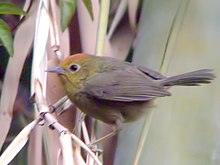Cyanoderma
| Cyanoderma | |
|---|---|

| |
| Rufous-capped babbler (Cyanoderma ruficeps) | |
| Scientific classification | |
| Domain: | Eukaryota |
| Kingdom: | Animalia |
| Phylum: | Chordata |
| Class: | Aves |
| Order: | Passeriformes |
| Family: | Timaliidae |
| Genus: | Cyanoderma Salvadori, 1874 |
| Type species | |
| Timalia erythroptera (chestnut-winged babbler) Blyth, 1842 | |
| Species | |
|
See text | |
Cyanoderma is a genus of passerine birds in the Old World babbler family Timaliidae. Many of these species were formerly placed in the genus Stachyris
Taxonomy
A molecular phylogenetic study published in 2012 found that the genus Stachyris was paraphyletic. In the subsequent reorganization to create monophyletic genera, the genus Cyanoderma was resurrected to accommodate a group of species formerly assigned to Stachyris.[1][2] The genus Cyanoderma had been introduced in 1874 by the Italian zoologist Tommaso Salvadori with chestnut-winged babbler as the type species.[3][4] The name combines the Ancient Greek kuanos meaning "dark-blue" with derma meaning "skin".[5]
Species
The genus contains the following species:[2]
| Image | Common Name | Scientific name | Distribution |
|---|---|---|---|
 |
Chestnut-winged babbler | Cyanoderma erythropterum | Malay Peninsula, Sumatra |

|
Grey-hooded babbler[6] | Cyanoderma bicolor | Borneo |
 |
Crescent-chested babbler | Cyanoderma melanothorax | Java and Bali |
 |
Rufous-fronted babbler | Cyanoderma rufifrons | Sikkim, Bhutan Dooars and northeast India |
 |
Rufous-capped babbler | Cyanoderma ruficeps | Eastern Himalayas to northern Thailand, Laos, eastern China to Vietnam and Taiwan |
 |
Black-chinned babbler | Cyanoderma pyrrhops | the Himalayas from the Murree Hills in Pakistan to eastern Nepal |
 |
Golden babbler | Cyanoderma chrysaeum | the Eastern Himalayas to Southeast Asia |
 |
Buff-chested babbler | Cyanoderma ambiguum | Eastern Himalayas to south Laos |
Deignan's babbler Cyanoderma rodolphei collected in 1939 at Doi Chiang Dao in Thailand is considered synonymous with the rufous-fronted babbler.[7]
References
- ^ Moyle, R.G.; Andersen, M.J.; Oliveros, C.H.; Steinheimer, F.D.; Reddy, S. (2012). "Phylogeny and biogeography of the core babblers (Aves: Timaliidae)". Systematic Biology. 61 (4): 631–651. doi:10.1093/sysbio/sys027. PMID 22328569.
- ^ a b Gill, Frank; Donsker, David; Rasmussen, Pamela, eds. (August 2022). "Babblers & fulvettas". IOC World Bird List Version 12.2. International Ornithologists' Union. Retrieved 23 September 2022.
- ^ Salvadori, Tommaso (1874). "Catalogo sistematico degli uccelli de Borneo". Annali del Museo Civico di Storia Naturale di Genova (in Italian and Latin). 5: 1–380 [213].
- ^ Mayr, Ernst; Paynter, Raymond A. Jr, eds. (1964). Check-List of Birds of the World. Vol. 10. Cambridge, Massachusetts: Museum of Comparative Zoology. pp. 301–302.
- ^ Jobling, James A. (2010). The Helm Dictionary of Scientific Bird Names. London: Christopher Helm. p. 126. ISBN 978-1-4081-2501-4.
- ^ "Species Updates – IOC World Bird List". Retrieved 2021-05-28.
- ^ Collar, N. J. (2006). "A partial revision of the Asian babblers (Timaliidae)" (PDF). Forktail (22): 85–112.
